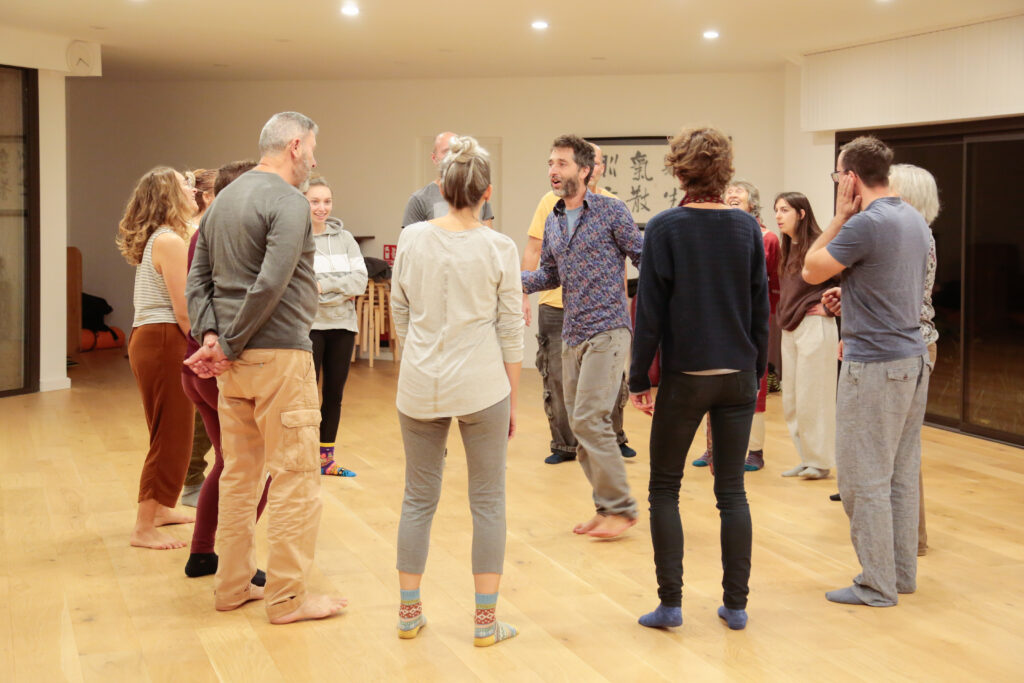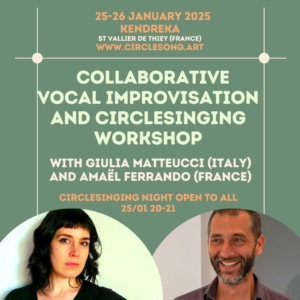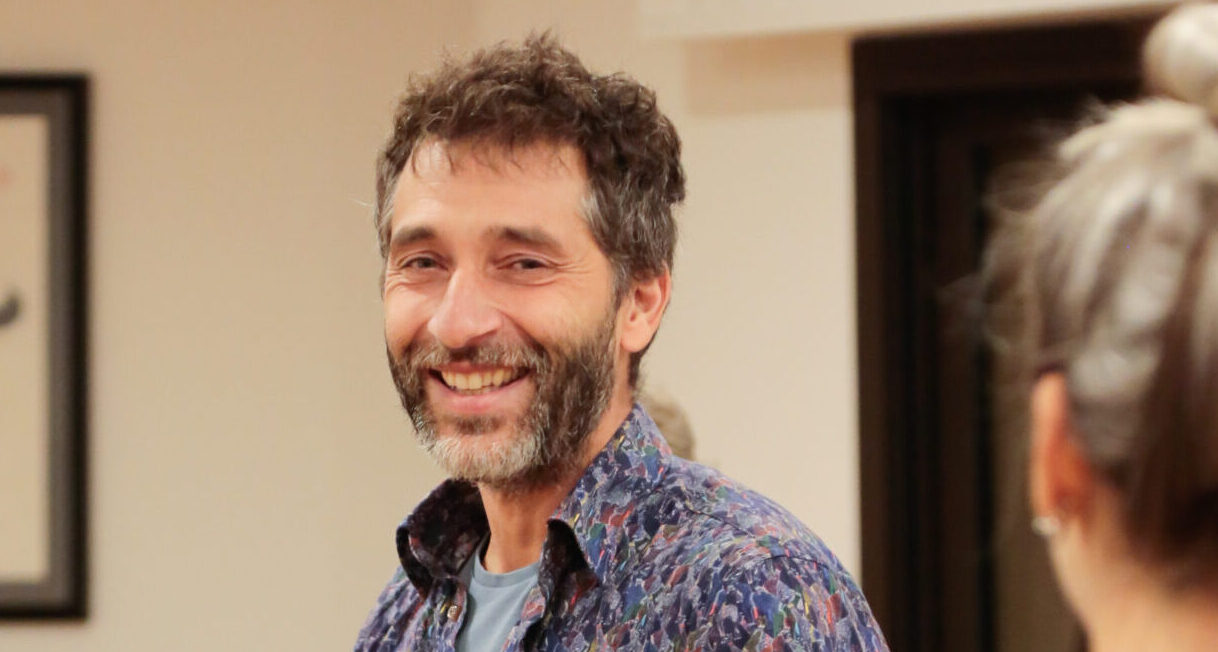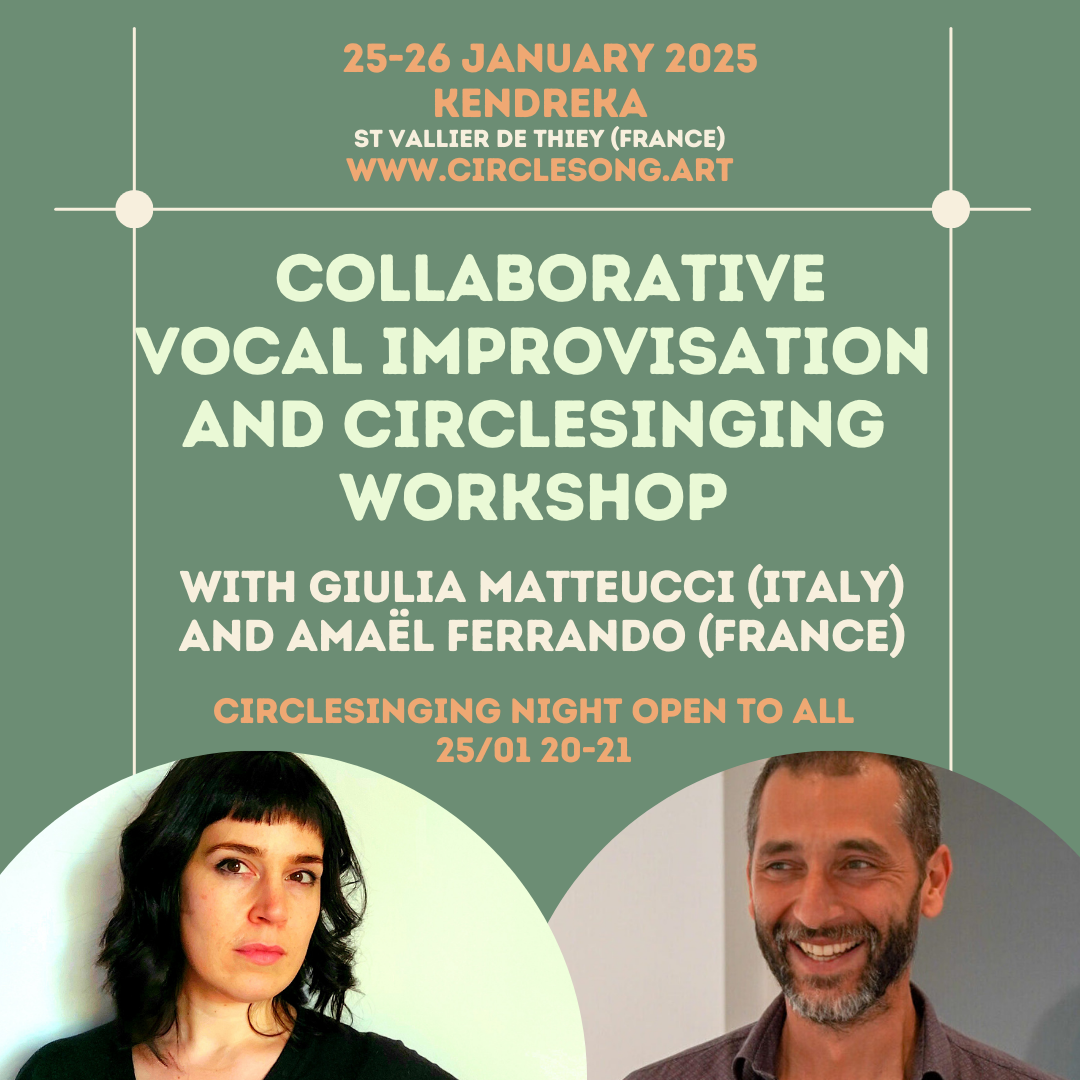What if singing were accessible to everyone?
What if there were a space for expression that was both entirely free and in perfect harmony with the collective?
What if musicians and non-musicians, singers and non-singers could vibrate, laugh, explore together, and learn from one another?
What if it were possible to reclaim your voice and your singing in a playful and inclusive way, without sacrificing the richness and complexity of musical, rhythmic, and harmonic art?
Rooted in the collective songs of our distant ancestors across the five continents, circular singing and its many variations offer this reconnection, blending repetitive singing with the freedom of improvisation.
Circlesongs provide a glimpse into what human exchanges might have been like before our culture began to separate “singers” from “non-singers,” before the vital song of each individual became a strange and foreign thing, observed in concert halls or passively consumed through electronic devices.
To sing is to enjoy one of our natural faculties, as innate as breathing or walking—a natural power that has been taken away, divided into the roles of performer and spectator.
We once sang to celebrate, to heal, to lull children to sleep, to accompany the dying, to communicate with the spirits of nature, and for countless other purposes now forgotten…
This is an invitation to return to that vital source.
What is Circlesinging?
Circlesongs: An Exploration of Collective Improvised Singing
Circlesongs, or “circular songs,” are a collective musical practice of vocal improvisation based on repetitive motifs that lead singers into a unique state of connection and openness.
This ancient art was popularized in the 1980s by Bobby McFerrin and has since evolved across countless styles, embraced by groups and choirs worldwide. Participants gather in a circle to create musical loops using their voices in all their versatility, including vocal beatboxing and body percussion.
The singing often revolves around repetitive patterns that evolve throughout the session, creating a dynamic and immersive musical experience for both the singers and the audience.
Following in Bobby McFerrin’s footsteps, many contemporary artists incorporate elements of Circlesongs into their performances, such as Jacob Collier and Ibrahim Maalouf, to name just a few.
Beyond the realm of performance, however, it is the inner state experienced by the singers that has fueled the global growth of this practice. Movements like The Well, Chant Pour Tous, Musica do Circolo, and many others, along with numerous festivals and events, continue to spread this art form around the world.
Circlesongs engage the individual in their relationship with their voice and inner rhythm, while also connecting to the collective dynamic of the circle—a reflection of cosmic rhythms and harmonies.
When these three levels merge—individual, collective, and cosmic—it creates an unforgettable experience.
Amaël Ferrando
Discover Circlesongs with us!
If none of these options suit your needs, why not contact us to organize a workshop or session at your location, workplace, or event?
Principles of circlesongs
The principles of circlesongs are simple: people gather in a circle. A first person sings a motif that he or she will repeat in a loop (hence the notion of “circle”). On this basis, a second singer creates another musical motif that is superimposed on the first. Then a third, and so on. The result is a collective musical construction, each piece of which is quite simple, while the whole is often very rich, sometimes complex. In a large group (more than 6 or 8 people), each loop will be sung by a small group of a few singers, in order not to multiply the number of voices to infinity. In many current forms, one or more leaders placed in the center of the circle create and distribute the voices and lead the group, making it a musical form in its own right.
Ancient history
This repetitive musical construction is the basis of many traditional songs, especially worksongs, songs sung by workers to get them going. These worksongs seem to be present in all human cultures. The singing, with the breath, makes the singer enter a particular state, close to trance, ideal for example for many works in the fields (cotton picking, weeding of rice fields, winnowing of cereals, wood cutting, etc.), long walks, shamanic or religious ceremonies…
Recent history
At the end of the 1980s, the singer Bobby McFerrin explored this musical construction in his Voicestra project. The first recording, almost ten years later, is a record soberly entitled “Circlesongs” released in 1997 by Sony. This record awakened many vocations around the world by re-emerging circlesongs as an art form. In 2010, another album, “Vocabularies”, was released, the result of 7 years of work by McFerrin with composer Roger Treece and over 50 singers. Extremely ambitious, this second album places the circlesongs in musical contexts of a complexity and musicality that were previously unknown. Many singers saw it as a suitable form for the expression of their musical creativity. Many of them associate research and encounters with traditional music, such as Leila Martial with the songs of the Aka of Congo.
Multidimensional circlesong
As we have understood, the origin of circlesong is not stage performance, but a way of being together, of meeting as humans (oneself and one’s companions), and eventually of meeting other states of consciousness. If this practice is so successful, it is not primarily as music to be listened to, but as music to be co-created, as an irreplaceable life experience: the experience of being in the same rhythmic pulse, the same harmony with other humans. This is why some of today’s best-known circlesingers, such as the Frenchman Gaël Aubrit, creator of Chant Pour Tous, or the Brazilian collective Musica Do Circolo, place empathic communication (NVC) or collaborative creation at the basis of their practice. Participants come to experience this immersion in rhythm, sound, harmony, sometimes movement or body percussion. The feeling of social inclusion, of belonging to the circle, of inner and outer harmony that comes from it is for many participants an outstanding experience.
My approach to Circlesong
Initially trained in vocal improvisation within Indian music and Jazz (Berklee College of Music, Boston), I discovered Circlesongs with wonder through Gaël Aubrit and David Eskenazy. Through masterclasses and collaborations, I had the opportunity to deepen various aspects of this practice with Joey Blake (United States), Musica Do Circolo (São Paulo), Guillermo Rozenthuler (London), Giulia Matteucci (Italy), among others.
With the workshops and training sessions I offer, I synthesize my learnings in Circlesongs, connecting them to my musical background as well as my experience with movement and energy through Qigong. These Circlesongs recreate the bond between rhythm, sound, movement, and energy, helping us rediscover and develop our original nature.
Où pratiquer les Circlesongs ?
Circlesongs are becoming increasingly popular in France, as well as in many countries across Europe and the world. In France, the Chant Pour Tous movement has played a significant role in the rise of circular singing. You can discover or deepen your experience with Circlesongs here:







